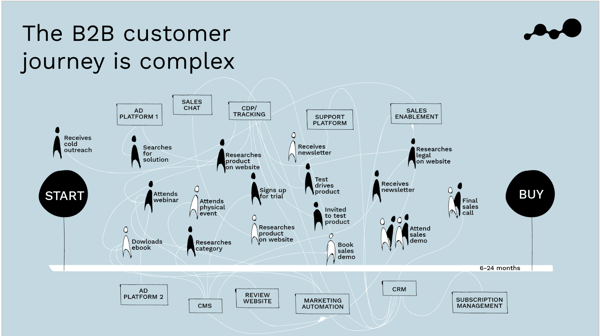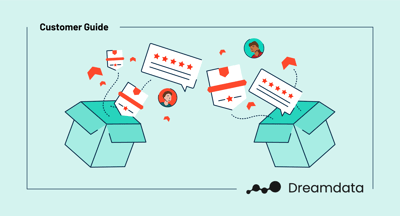August 2, 2023
 by Soundarya Jayaraman / August 2, 2023
by Soundarya Jayaraman / August 2, 2023

Which marketing strategies truly drive precious sales? As a B2B marketer, you always have this question on your mind.
Revenue attribution is an answer you may not have considered. It shows how your potential customers navigate their way to conversion and how each touchpoint contributes to your bottom line.
But where do you start your revenue attribution journey, and how should you go about it?
I was asking myself the same things, and thankfully, I had the opportunity to sit down to discuss solutions with an expert in the field of revenue attribution in B2B marketing: CMO and co-founder of Dreamdata.io, Steffen Hedebrandt.
Drawing from his personal struggles with showing value for his marketing efforts during his early days to solving the same problem today with Dreamdata.io, Steffen shares his perspective on revenue attribution, how it helps with complex B2B customer journeys, and what marketers should do to get it right.
We also talk about how marketers need to be proactive during these unsteady times and find methods that create lasting impact. So, grab your tea and read on.
This interview is part of G2's Professional Spotlight series. For more content like this, subscribe to G2 Tea, a newsletter with SaaS-y news and entertainment.
What's your favorite beverage? Sparkling water. Sometimes a Coke Zero or draught beer.
When do you enjoy it? Just everyday usage during lunch and dinner.
What was your first job? My first ever job was delivering newspapers.
What's your favorite software in your current tech stack? Dreamdata and Google apps. That’s probably what I use the most.
What problems at work make you want to throw your laptop out the window? Two things come to mind. One is when customers decide to churn. It annoys me a lot. The other thing right now is what we are working on [at Dreamdata]. In this category and positioning, there are no answers that are just given, and you’ll never know whether you'll make the right choice or not. So, it can be a little bit of frustrating work sometimes.
Soundarya Jayaraman: Let’s first talk about your journey in the B2B marketing space. Tell us about how you landed where you landed.
Steffend Hedebrandt: In my first job out of university, I worked on trying to build a vintage music instrument platform. We were trying to get different physical shops to put their instruments on our website. That's where I got my first lesson.
“Activities need to have a revenue outcome. Otherwise, you run out of money.”
Steffen Hedebrandt
Chief Marketing Office & Co-founder, Dreamdata.io.
We grew that website to having hundreds of thousands of organic visitors because the instruments were ranking really well on Google. But we didn't manage to get the shops to pay us a subscription for this traffic. This was unfair because some shops would be getting thousands of visitors every month from our side.
This has been the focus ever since – if you want to be really appreciated for your marketing efforts, you need to have a narrative of why you're doing things and how it benefits the company, and the ultimate expression of that is more revenue. And if it's not more revenue, then you need to explain why the other things that come out of it are valuable.
Your professional journey illustrates a good story of how and where you started, the problem you dealt with, and how you are now solving it in your current position in Dreamdata: revenue attribution. I have a very basic question here. Is there a difference between revenue attribution and marketing attribution?
It’s good that you ask. We at Dreamdata very deliberately talk about revenue attribution as opposed to marketing attribution because if you talk about marketing attribution, it's like somebody clicked an ad, and then money came out later.
But in B2B, you typically click an ad, sign up for a newsletter, and get contacted by a sales development representative [SDR]. The sales team works with you for three months, and then you sign a contract. We are in the business of trying to understand anything that happens related to buying, as opposed to just understanding whether the ad had an outcome.
So it's not just about the marketing that's being done, but it’s about every touchpoint throughout the whole customer journey, correct?
Yes, you can see that the scope of data is much wider when you talk about revenue attribution as opposed to just talking about marketing attribution.
This brings me to another question related to the customer journey. G2 recently did a survey of B2B buyers and found around 65% of buyers spend a lot of time just researching and evaluating. Gathering from what you just said, you also point to a long customer journey. Can you tell us a bit more about the B2B buyer’s journey today and what marketers should keep in mind about it?
Based on our customer data, we could see that the average customer journey from the first touch of an account until one buy was 192 days and had 31 touches before the deal is closed.
And I think this is still an underestimation of what goes on because there's also stuff that customers haven't tracked digitally. Perhaps you did a phone call from your own phone to talk to the customer, or perhaps you met them at a conference, but never registered that in your CRM system.

Source: Dreamdata.io
So there are a lot of touches that are not digitally captured, but it is still also part of the customer journey. All these signals show that the B2B customer journey is quite complex and takes a long time.
The important part for marketers that it highlights is that you need to think about how you plan stuff. If, in Q4, the salespeople need to hit a certain sales target, then the leads and the marketing input to hit this target must date back 192 days.
In order for that to happen, you plant a lot of seeds early, and for it to actually prosper into something that the salespeople can work on. If you have a year and there's a target, then you need to think and plan ahead before or when the year starts. The marketing and sales teams actually work together on hitting the targets they set out to.
How does revenue attribution help marketers with this process of planting the early seeds, as you say?
Because of all these complexities we just talked about, most businesses don't understand the dynamics of what they do. So they are operating very blindfolded when it comes to understanding how they actually make money.
They know that a salesperson gets a contract signed, but a contract signed is just the very last step of a long journey. And that means if you're not able to kind of reverse engineer what happened up to the contract getting signed, then it's very hard for you to know what we should be doing more. Should we do more events or write more content or have more eBook downloads or buy more ads?
“What you should use is this understanding of the customer journeys…and replicate what's been successful and also stop the projects where you are most likely wasting money.”
Steffen Hedebrandt
Chief Marketing Office & Co-founder, Dreamdata.io.
But the problem is that 9 out of 10 people, particularly in B2B marketing, don't have the insights into what happens six months from now from the activity that I do today.
Put a little roughly, that’s why you also see when there is pressure on financial optimism, the first people you go after firing are people in the marketing department because they don't have the proof despite the truth that they are very valuable. But they don't have the available truth tracked with revenue attribution. And when you don't have that, then you can't defend yourself.
Apart from what you have shared now, what is something you would say that marketers should know but don’t know about revenue attribution today?
One is that a lot of marketers are not very aware of revenue attribution as such. It’s one of the challenges we have in our work. People don't know what they don't know.
And the other would be revenue attribution is actually a lot more mature than what most marketers understand.
“You can actually get quite good insights nowadays into what's happening, at least if you're a very digital company where you spend most of your marketing efforts digitally.”
Steffen Hedebrandt
Chief Marketing Office & Co-founder, Dreamdata.io.
The salespeople use the CRM system, the calling software, and you have a product that you deliver digitally as well. Because then you kind of have a full cycle of a customer journey, mainly digital. What we do at Dreamdata.io is to educate people that it’s actually all possible.
You mention that marketers can get a lot more insights into the customer journey with revenue attribution. Now what’s the data B2B marketers can track that helps with revenue attribution?
If you have a conversation about how our customer journeys look, then you can think through which part of it actually leaves behind the digital impressions.
A simple thing can be if the salespeople use their own phone, not using calling software, then you can ask your sales team, “Now you have to call using a piece of software that logs who you talk to, how long, and which account they belong to.” If you start running digital ads, you will understand the impact of it.
A typical component people miss when they become customers with us is that they have not been tracking their website with a first-party data provider or tracking solution. That means that if you're using Google Analytics, it's Google Analytics that tracks and stores your data.
But there's a very growing industry of what is called first-party tracking where you take some tool and put it on your website and track your own website and store the data yourself like Dreamdata or Segment and other providers.
But it's typically this component that people have not thought about. They've just been using Google Analytics for the last 15 years. And they've not thought about how the ownership of the data is with Google and not with themselves. It’s a critical component companies are missing.
If B2B marketers want to get started with revenue attribution, what are some things they should keep in mind?
There are a couple of things that I want to highlight. The tools that are being used to measure marketing today are insufficient. For example, Google Analytics cannot tell you anything about how your content impacts revenue because when the customer journey is 192 days, then Google Analytics gets completely lost. It doesn't receive the revenue component in B2B.
In B2C, for example, you sell something, Shopify recognizes this, and you have the number. But in B2B, somebody comes to the website, and then someone else checks your product, and then their boss signs the contract. Google Analytics cannot help you here.
In CRMs, again, they have the problem of not knowing the history that took place before data arrived at the CRM. So when marketers are being judged by this lead source or original source field in CRM, it's an incredibly flawed place to look.
The last thing I would mention is also the ad platforms have no clue about it. They can tell, “You bought a click from me, it cost you $1, and maybe you got an email from the ad.” But they don't know whether that email turned into a customer or was it just a waste of money.
All these things where marketers are judged are typically the wrong way to do it. That leads to them making wrong decisions about what they should do next.
Should they just do the things that they can prove, or should they do other things? When you come to this realization, the next thing you should do is fix it. And that is going through this pocket list of what we can actually get to deliver digital traces when we do our activities.
Let's say you now have the data. Then it needs to be modeled into account-based timelines instead of the timeline of individuals, which is typically a job you'll get some data engineers to do for you.
The reason why an account-based timeline is important is that if there are three people involved in the deal, then the thing that starts the deal will typically be a marketing activity, like content or ads. And then they go tell their colleague, “I found this product.”
Once the product is approved, then somebody else signs the contract. This makes the marketing activity look like a cost because it's not connected to the rest of the journey. It looks like somebody just came directly and signed a contract, and you got money. But that's not very actionable for marketers.
With revenue attribution, ultimately, we want to enable our customers to do more things that we can prove to them, produce revenue, and stop doing the things that don't. We want either to save that money or take that money and put it into the pocket of things that are clearly working.
From your experience as a marketer, what are the benefits you have seen from revenue attribution?
The main outcome for many of our customers is that they start getting much more out of the money they spend. That means the customer acquisition cost is lowered because they get more out of every dollar they spend. And they also grow faster in terms of revenue because they now put their marketing money into where it has an impact.
In simple terms, it can be things like you get twice as many demo calls for the same money you spent. It can be that the quality of the leads you bring in is higher, and there are many different things that revenue attribution improves.
A doubt many marketers have about revenue attribution when they start is what attribution model they should use. From your experience, what’s a good place to start?
Now, attribution models are only helpful if you've actually tracked a full journey. Imagine using an attribution model that tracks until the point you get an eBook download. Now that might lead to you understanding how you produce eBook downloads, but it doesn't tell you which of those eBook downloads goes on to you selling something.
You need to, first of all, you need to solve the data problem of having the whole journey accessible. That is the first problem. Once solved, the attribution model marketers use is an opportunity to highlight certain parts of the journey.
For example, I really like the first touch attribution model, meaning “What is the first thing we know about the accounts?” So if there are 1,000 accounts, I only care about the accounts we win. I want to know the first touch of those accounts because they are the ones that are high quality, whereas going for the first touch of accounts that you don't win or don't move down your sales pipeline doesn't matter too much.
So your personal preference as a marketer is the first-touch model?
Yes. As a marketer, I feel like a lot of what we are in the world for is starting the journey or at least building the first part of the journey – to make people aware and understand the product.
The last part of the journey is typically sales work. If you did a last touch model on a 192-day journey, almost always, it will be a meeting, a call, or something that sales would be doing.
As a marketer, you want to understand the first part of the journey with your model. So those are the models that I'm mainly interested in.
At Dreamdata, we also have a data-driven model, which is machine learning-based. It calculates what are the touches that are the most important on the journey. So if a journey has 100 touches, it will look at all the 100 touches and then try to remove them one by one and then see if that impacts whether we won or not. It can help surface some things that may not come up usually.
For instance, not the first touch or the last touch, but this touch number seven is always important, and this doesn't show up in one of the normal rule-based models. But because the machine calculates the importance of it, it could be that the blog post you wrote is always there when you sell. It will start showing the impact. And this is very important.
“But remember, you can only use a model if you actually have the data.”
Steffen Hedebrandt
Chief Marketing Office & Co-founder, Dreamdata.io
So any model – let's say you only have 5% of the journey – then any model you apply, first touch or last touch, might take you on the wrong path because you actually don't have the full journey available to get that particular data.
Since you stress a lot about getting the data right for revenue attribution, what must marketers do to get it right?
That’s actually making the customer journey available through data. What we typically use is the CRM system, where you have calls, meetings, emails, and the revenue component. And then, we might take data from the marketing automation system or the intent data from G2 before they came to your website and then scripts that track when people came to the website – where did they come to and what did they look at?
So you think about the whole journey and then understand which of these parts today leaves behind these traces and what does not. And if there are black spots, you need to think, “Can we start to shine some light on these?”
My last question to you is about the situation marketers are facing today. Given the current market conditions, it's not easy generating demand and leads. We see a lot of talk about missing targets and budget cuts. Marketers are under pressure to show practical value with a limited budget. What’s your advice to B2B marketers out there in this situation?
Be super curious about where customers come from. I continuously ask this question when we win a customer: “What is the narrative when we win a customer?” If we do A, B, and C, do we see D coming out of it? Once you start to understand how things connect, then you will also be able to identify which of your activities you should probably do more or less.
A good rule of thumb is that if you doubt whether something works, it doesn't. And those things are typically the things you want to proactively scratch in these times and then go back to your CFO and say, “Hey, we've just stopped this to save some money because we were unsure about its impact.”
As a marketer, you are either given the budget, meaning the CFO tells you this is what you have. Or you can give the budget if you're being proactive and say, “Here's my plan. This is what we need, this is why we need it. This is what I expect to come out of it.”
Follow Steffen on LinkedIn to learn more about B2B revenue attribution.
Soundarya Jayaraman is a Content Marketing Specialist at G2, focusing on cybersecurity. Formerly a reporter, Soundarya now covers the evolving cybersecurity landscape, how it affects businesses and individuals, and how technology can help. You can find her extensive writings on cloud security and zero-day attacks. When not writing, you can find her painting or reading.
The average B2B customer completes around 57% of the buying process before ever even engaging...
 by Jeremy Sacramento
by Jeremy Sacramento
Most B2B marketers think buyers are rational first and emotional later. They are wrong.
 by Sidharth Yadav
by Sidharth Yadav
What’s one thing every marketing leader and athlete agrees on? That short-termism is the enemy...
 by Kamaljeet Kalsi
by Kamaljeet Kalsi
The average B2B customer completes around 57% of the buying process before ever even engaging...
 by Jeremy Sacramento
by Jeremy Sacramento
Most B2B marketers think buyers are rational first and emotional later. They are wrong.
 by Sidharth Yadav
by Sidharth Yadav


